
This is my own personal list of the top films of the 70's. It includes my own views, as well as views from e-mails, other critics and websites. I tried to include films from all the main genres; including, war, horror, sci-fi, romance, kid's, etc. As well as movies that were groundbreaking from a technology point of view or changed the industry in some way. I did not include foreign films. The top films are placed in alphabetical order. Each are great in their own way and would be quite difficult to arrange in a 1-20 list. The movie titles are linked to the IMDB (Internet Movie Database) which contains extra information on each film, including the cast and crew. To get back to my site from this link, you will need to use the "back" button. By viewing these 20 films, I believe you will have a great feel for what the American film was all about in the 70's.
American Graffiti (1973)

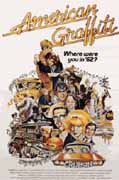 Before George Lucas became known as the man who created the Star Wars universe, he made another classic film, "American Graffiti". Francis Ford Coppola helped finance less than one million dollars, to this still somewhat unknown Lucas and his movie, which ended up being one of the top grossing films to this date. Based on Lucas's memories of his own teen years in Modesto, California, the film pays tribute to the innocent era of the early 60's. A time of driving around in cars with the top down, picking up girls, eating hamburgers at the drive-in, and listening to the radio. The soundtrack contains all the classics of the early rock era, and the cast would soon be all quite well known; Ron Howard, Richard Dreyfuss, Cindy Williams, Mackenzie Phillips, Suzanne Sommers, Wolfman Jack and Harrison Ford. Appears on AFI's Best Movies of all time list at 77.
Before George Lucas became known as the man who created the Star Wars universe, he made another classic film, "American Graffiti". Francis Ford Coppola helped finance less than one million dollars, to this still somewhat unknown Lucas and his movie, which ended up being one of the top grossing films to this date. Based on Lucas's memories of his own teen years in Modesto, California, the film pays tribute to the innocent era of the early 60's. A time of driving around in cars with the top down, picking up girls, eating hamburgers at the drive-in, and listening to the radio. The soundtrack contains all the classics of the early rock era, and the cast would soon be all quite well known; Ron Howard, Richard Dreyfuss, Cindy Williams, Mackenzie Phillips, Suzanne Sommers, Wolfman Jack and Harrison Ford. Appears on AFI's Best Movies of all time list at 77.
Annie Hall (1977)
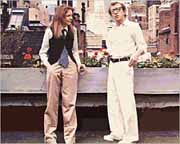 This wonderful and humorous movie is based on the real life romance of the director and star, Woody Allen and the female lead Diane (nicknamed Annie) Keaton (real last name Hall). Woody Allen plays his basic neurotic, Jewish, New Yorker who is having relationship troubles, psychologically, religiously and culturally. The film follows his on-again, off-again relationship with Keaton, the all American midwest girl, told through flashbacks, monologues and short sequences. The film established Allen as a major director and Keaton started a fashion trend with her baggy pants, vest and hat. The movie is filled with classic lines and scenes, with my personal favorite being the couples first date, standing on a roof deck giving small talk, with subtitles below telling the audience what they are really thinking. Appears on AFI's Best Movies of all time list at 31.
This wonderful and humorous movie is based on the real life romance of the director and star, Woody Allen and the female lead Diane (nicknamed Annie) Keaton (real last name Hall). Woody Allen plays his basic neurotic, Jewish, New Yorker who is having relationship troubles, psychologically, religiously and culturally. The film follows his on-again, off-again relationship with Keaton, the all American midwest girl, told through flashbacks, monologues and short sequences. The film established Allen as a major director and Keaton started a fashion trend with her baggy pants, vest and hat. The movie is filled with classic lines and scenes, with my personal favorite being the couples first date, standing on a roof deck giving small talk, with subtitles below telling the audience what they are really thinking. Appears on AFI's Best Movies of all time list at 31.
Apocalypse Now (1979)
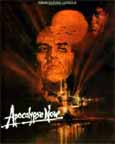
 Francis Ford Coppola's nightmarish look at the Vietnam war. Inspired by Joseph Conrad's book, "Heart of Darkness", the story follows Captain Willard (played by Martin Sheen) and his danger-filled journey to find a man named Kurtz. This mysterious man, played by Marlon Brando, is a highly decorated U.S. officer that the army believes has gone mad. He has hid himself deep in the jungle and is posing as an idol to a native Cambodian tribe. The photography by Vittorio Storaro is mesmerizing and contains a kaleidoscope of war horrors. The ending is a little too surreal, murky and confusing, but I guess that sums up the war as well. I must admit, I was never a huge fan of this film, but I understand its artistic merit. Robert Duvall's scene showing him leading a armored assault on a beach, with Wagner's music blaring in the background, is a haunting image of the thirst for war by some people. Appears on AFI's Best Movies of all time list at 28 (Much too high).
Francis Ford Coppola's nightmarish look at the Vietnam war. Inspired by Joseph Conrad's book, "Heart of Darkness", the story follows Captain Willard (played by Martin Sheen) and his danger-filled journey to find a man named Kurtz. This mysterious man, played by Marlon Brando, is a highly decorated U.S. officer that the army believes has gone mad. He has hid himself deep in the jungle and is posing as an idol to a native Cambodian tribe. The photography by Vittorio Storaro is mesmerizing and contains a kaleidoscope of war horrors. The ending is a little too surreal, murky and confusing, but I guess that sums up the war as well. I must admit, I was never a huge fan of this film, but I understand its artistic merit. Robert Duvall's scene showing him leading a armored assault on a beach, with Wagner's music blaring in the background, is a haunting image of the thirst for war by some people. Appears on AFI's Best Movies of all time list at 28 (Much too high).
Cabaret (1972)
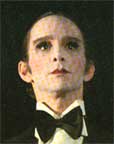
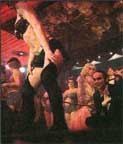 One of the great things about making up these lists is the chance to revisit films I haven't seen in a long time and take another look. I put this movie on when I was writing this list and was happy to see Bob Fosse's classic musical again. It is very sad to think that this is possiblily the last great musical to come out of Hollywood. I'm not sure what happen to this genre, but it needs to be brought back!!! One of surprises about this film was the fact that it really took the musical into a new direction. The early musicals consisted of boy meets girl, boy loses girl, boy wins girl. A little conflict began to appear in "Oklahoma", "South Pacific", and "West Side Story", but they were still somewhat tame. "Cabaret" blew that all away. The story begins in Germany around 1931. The Nazis have not taken complete control of the country yet, and the local Cabaret is filled with fun, laughter and bawdy entertainment. An American singer, working at the club, begins to fall in love with a very proper Englishman. As the relationship grows, we begin to see the country slowly falling apart around them. Only in the 70's, could a film begin to portray bisexuality, easy women, and the horrors of Nazism with such taste. The movie was a star vehicle for Liza Minnelli, but I think the true star was Joel Grey as the "host" of the KitKat Club. Bob Fosse directed the film like no musical seen before, too bad others didn't pick up the trend.
One of the great things about making up these lists is the chance to revisit films I haven't seen in a long time and take another look. I put this movie on when I was writing this list and was happy to see Bob Fosse's classic musical again. It is very sad to think that this is possiblily the last great musical to come out of Hollywood. I'm not sure what happen to this genre, but it needs to be brought back!!! One of surprises about this film was the fact that it really took the musical into a new direction. The early musicals consisted of boy meets girl, boy loses girl, boy wins girl. A little conflict began to appear in "Oklahoma", "South Pacific", and "West Side Story", but they were still somewhat tame. "Cabaret" blew that all away. The story begins in Germany around 1931. The Nazis have not taken complete control of the country yet, and the local Cabaret is filled with fun, laughter and bawdy entertainment. An American singer, working at the club, begins to fall in love with a very proper Englishman. As the relationship grows, we begin to see the country slowly falling apart around them. Only in the 70's, could a film begin to portray bisexuality, easy women, and the horrors of Nazism with such taste. The movie was a star vehicle for Liza Minnelli, but I think the true star was Joel Grey as the "host" of the KitKat Club. Bob Fosse directed the film like no musical seen before, too bad others didn't pick up the trend.
Chinatown (1974)
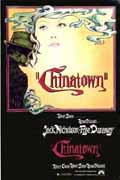
 This wonderful homage to the film noir of the 50's contains all the vintage elements. The film is set in Los Angeles during the 1930's. Jack Nicholson plays J.J. Gittes, a somewhat seedy private investigator who takes on a simple sounding case of infidelity. Faye Dunaway is the femme fatale who pulls Gittes into a complex mystery of false identities, investment schemes, controlling of the water supply and incest. Roman Polanski directs a moody picture from Robert Towne's wonderful script inspired by Chandler. Polanski also makes a cameo in the picture as a thug with a knife. The production design perfectly creates L.A. of the 30's and the tempo of the film accelerates as it pulls you deeper into the mystery. Appears on AFI's Best Movies of all time list at 19.
This wonderful homage to the film noir of the 50's contains all the vintage elements. The film is set in Los Angeles during the 1930's. Jack Nicholson plays J.J. Gittes, a somewhat seedy private investigator who takes on a simple sounding case of infidelity. Faye Dunaway is the femme fatale who pulls Gittes into a complex mystery of false identities, investment schemes, controlling of the water supply and incest. Roman Polanski directs a moody picture from Robert Towne's wonderful script inspired by Chandler. Polanski also makes a cameo in the picture as a thug with a knife. The production design perfectly creates L.A. of the 30's and the tempo of the film accelerates as it pulls you deeper into the mystery. Appears on AFI's Best Movies of all time list at 19.
The Clockwork Orange (1971)

 This movie has haunted me for quite some time. I'm not sure how old I was when I first saw it, but I know it was quite young, too young to understand what was going on. My brother had brought it home on video and I watched in horror. Is this what the future had in story for me? I had nightmares for days. This film still scares me, mainly because of how much of it seems to be coming true. The story is set in the not to distant future and centers around Alex (played by Malcolm McDowell) and his gang of "Droogs" whose purpose in life is to cause "a bit of the old ultraviolence". They search for innocent people that they can beat-up, torture, rape and kill. After a burtal assault, made even more terrifying with the joyful song "Signin in the Rain" being sung, Alex is captured by police and is sent to a reprogramming center. He is released after being brainwashed to decriminalize him. The question is, does this truly work? Taken from the Anthony Burgess novel, Stanley Kubrick continued with his amazing run of unique, creative and visually stunning motion pictures. This is NOT for everyone's taste and was orginally released with an X rating because of the violence. Most videos contain the R version, which is still shocking. Appears on AFI's Best Movies of all time list at 46.
This movie has haunted me for quite some time. I'm not sure how old I was when I first saw it, but I know it was quite young, too young to understand what was going on. My brother had brought it home on video and I watched in horror. Is this what the future had in story for me? I had nightmares for days. This film still scares me, mainly because of how much of it seems to be coming true. The story is set in the not to distant future and centers around Alex (played by Malcolm McDowell) and his gang of "Droogs" whose purpose in life is to cause "a bit of the old ultraviolence". They search for innocent people that they can beat-up, torture, rape and kill. After a burtal assault, made even more terrifying with the joyful song "Signin in the Rain" being sung, Alex is captured by police and is sent to a reprogramming center. He is released after being brainwashed to decriminalize him. The question is, does this truly work? Taken from the Anthony Burgess novel, Stanley Kubrick continued with his amazing run of unique, creative and visually stunning motion pictures. This is NOT for everyone's taste and was orginally released with an X rating because of the violence. Most videos contain the R version, which is still shocking. Appears on AFI's Best Movies of all time list at 46.
Close Encounters of the Third Kind (1977)

 Speilberg's second major release proved to the world that "Jaws" wasn't a one hit wonder for this young director, who also wrote the story for this film. And unlike most directors, Speilberg did not let the amazing special effects take away from the story. Richard Dreyfuss stars as one of many people who begin having strange dreams and sighting of UFO's. He begins to accept the truth that we are not alone, even though he is surrounded by a family of non-believers. This obsession eventual leads him to Devil's Tower mountian where the first contact with space beings occur. The story also threw a twist on many of the conceptions set up by sci-fi movies of the past fifty years. Gone were the Martians trying to take over the earth. In fact, most of the humans in the film are far more threatening than the childlike space aliens. Speilberg would continue this theme in the 80's with "ET". The last twenty mintues of the movie works like a silent film, with very little dialogue. The amazing visuals, sound (which won the film a special acheivement Oscar) and music by John Williams speak more than any words could say. I was luckily enough to catch this film on the big screen when it was first released. The arrival of the mothership was eye popping on the large scale. Appears on AFI's Best Movies of all time list at 64.
Speilberg's second major release proved to the world that "Jaws" wasn't a one hit wonder for this young director, who also wrote the story for this film. And unlike most directors, Speilberg did not let the amazing special effects take away from the story. Richard Dreyfuss stars as one of many people who begin having strange dreams and sighting of UFO's. He begins to accept the truth that we are not alone, even though he is surrounded by a family of non-believers. This obsession eventual leads him to Devil's Tower mountian where the first contact with space beings occur. The story also threw a twist on many of the conceptions set up by sci-fi movies of the past fifty years. Gone were the Martians trying to take over the earth. In fact, most of the humans in the film are far more threatening than the childlike space aliens. Speilberg would continue this theme in the 80's with "ET". The last twenty mintues of the movie works like a silent film, with very little dialogue. The amazing visuals, sound (which won the film a special acheivement Oscar) and music by John Williams speak more than any words could say. I was luckily enough to catch this film on the big screen when it was first released. The arrival of the mothership was eye popping on the large scale. Appears on AFI's Best Movies of all time list at 64.
The Deer Hunter (1978)
 The first film to try and deal with the Vietnam War was groundbreaking. Blasted at first for being over 3 hours long and containing graphic voilence and racial stereotypes, the film ended up winning 5 Oscars including Best Picture. The story centers around 5 best friends from Pennsylvania who work together at the town steel plant in 1968. They hang out at the local bar drinking away their problems. One of the gang is getting married and it's the last time they will all be together since 3 of the guys are leaving in a few days for Vietnam. It cuts to them in a concentration camp as the men are made to play a terrifying game of Russian Roulette by their captors. The film shows events before during and after their war duty and depicts how this war effected everyone's lives. The cast was brillant, Robert DeNiro, Chistopher Walken, John Savage, John Cazale, Chuck Aspergen, and Meryl Streep. Wonderfully shows the friendships, heroics and horrors of man. Appears on AFI's Best Movies of all time list at 79.
The first film to try and deal with the Vietnam War was groundbreaking. Blasted at first for being over 3 hours long and containing graphic voilence and racial stereotypes, the film ended up winning 5 Oscars including Best Picture. The story centers around 5 best friends from Pennsylvania who work together at the town steel plant in 1968. They hang out at the local bar drinking away their problems. One of the gang is getting married and it's the last time they will all be together since 3 of the guys are leaving in a few days for Vietnam. It cuts to them in a concentration camp as the men are made to play a terrifying game of Russian Roulette by their captors. The film shows events before during and after their war duty and depicts how this war effected everyone's lives. The cast was brillant, Robert DeNiro, Chistopher Walken, John Savage, John Cazale, Chuck Aspergen, and Meryl Streep. Wonderfully shows the friendships, heroics and horrors of man. Appears on AFI's Best Movies of all time list at 79.
The Exorcist (1973)
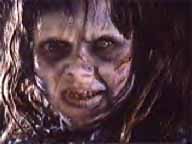 One of the few Horror films to ever receive any form of critical recognition. Willim Peter Blatty adapted his own best selling book about a 12 year old girl who is possessed by the devil. Two men of the cloth, a young priest (Jason Miller) and an elderly father (Max von Sydow) are called upon to do battle and rid the girl of the evil spirit. Director William Friedkin used cold, dark shots highlighted by graphic visual effects, which would set the standard for the horror genre. The slow transformation of the young Linda Blair, as the possessed girl, into a hideous monster was made even more horrific because of certain graphic scenes the director or story placed her in, including the language used and sexual situation. It continues to freaks me out!
One of the few Horror films to ever receive any form of critical recognition. Willim Peter Blatty adapted his own best selling book about a 12 year old girl who is possessed by the devil. Two men of the cloth, a young priest (Jason Miller) and an elderly father (Max von Sydow) are called upon to do battle and rid the girl of the evil spirit. Director William Friedkin used cold, dark shots highlighted by graphic visual effects, which would set the standard for the horror genre. The slow transformation of the young Linda Blair, as the possessed girl, into a hideous monster was made even more horrific because of certain graphic scenes the director or story placed her in, including the language used and sexual situation. It continues to freaks me out!
The French Connection (1971)
 This film centers around Jimmy "Popeye" Doyle, a New York City cop intent on breaking up an international drug ring. Gene Hackman was wonderful as Doyle and Roy Scheider played his partner. The depiction of street life and dialogue had an almost documentary feel to it, with many of the scenes shot on location. The scene that stands out is the chase. In fact, when people talk about chase sequences in motion pictures this is one of the first films people think about. Considered the best and or most famous chase sequences in the history of cinema People have tried to copy it, but never reach it's intensity and suspense. Popeye is on the tail of a suspect who hops aboard an elevated train. Hackman follows underneath in a car with very little regard to anyone or anything in his way. The chase ends with one of the classic images from the movies. It's been awhile since I've seen this film and I remember being a little disappointed in the ending, but the chase alone is worth a viewing. Appears on AFI's Best Movies of all time list at 70.
This film centers around Jimmy "Popeye" Doyle, a New York City cop intent on breaking up an international drug ring. Gene Hackman was wonderful as Doyle and Roy Scheider played his partner. The depiction of street life and dialogue had an almost documentary feel to it, with many of the scenes shot on location. The scene that stands out is the chase. In fact, when people talk about chase sequences in motion pictures this is one of the first films people think about. Considered the best and or most famous chase sequences in the history of cinema People have tried to copy it, but never reach it's intensity and suspense. Popeye is on the tail of a suspect who hops aboard an elevated train. Hackman follows underneath in a car with very little regard to anyone or anything in his way. The chase ends with one of the classic images from the movies. It's been awhile since I've seen this film and I remember being a little disappointed in the ending, but the chase alone is worth a viewing. Appears on AFI's Best Movies of all time list at 70.
The Godfather (1972), The Godfather 2(1974)

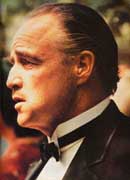 O.K. I admit, I cheated a little here. I realize that these are two seperate films, but even Coppola reedited these two movies together in chronological order and released it as "The Godfather Epic" in 1977. The story is taken from Mario Puzo's popular novel that follows the lives of the Corleones, an Italian family involved with the criminal Mafia. The first film tells of the final years of "the godfather", played by Marlon Brando, and his family who must begin to take over his father's criminal business. Al Pacino stars as the somewhat shy and timid, young son, who really wants nothing to do with the business, but eventual gets sucked into becoming the leader. The second film continues to follow Pacino as he turns the family crime business into a cold, sleek and mordern day organization. The second also goes back into time to show the orginal godfather, Brando's character now played by Robert DeNiro, as an ambitous, young immigrant in NYC and how he fell into the crime underworld. One element both films have is outstanding acting. You just can't find a better cast; besides for Brando, Pacino and DeNiro, they included James Caan, Robert Duvall, and Diane Keaton. Coppola also used amazing technical and storytelling skills to weave an epic tale over a two generational period of time. Considered an artistic masterpeice, but may be a little high on AFI's list of all-time movies at 3 & 32.
O.K. I admit, I cheated a little here. I realize that these are two seperate films, but even Coppola reedited these two movies together in chronological order and released it as "The Godfather Epic" in 1977. The story is taken from Mario Puzo's popular novel that follows the lives of the Corleones, an Italian family involved with the criminal Mafia. The first film tells of the final years of "the godfather", played by Marlon Brando, and his family who must begin to take over his father's criminal business. Al Pacino stars as the somewhat shy and timid, young son, who really wants nothing to do with the business, but eventual gets sucked into becoming the leader. The second film continues to follow Pacino as he turns the family crime business into a cold, sleek and mordern day organization. The second also goes back into time to show the orginal godfather, Brando's character now played by Robert DeNiro, as an ambitous, young immigrant in NYC and how he fell into the crime underworld. One element both films have is outstanding acting. You just can't find a better cast; besides for Brando, Pacino and DeNiro, they included James Caan, Robert Duvall, and Diane Keaton. Coppola also used amazing technical and storytelling skills to weave an epic tale over a two generational period of time. Considered an artistic masterpeice, but may be a little high on AFI's list of all-time movies at 3 & 32.
Jaws (1975)
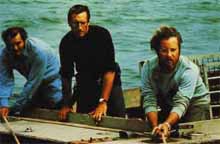
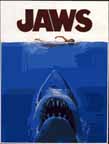 The movie that put Steven Speilberg on the map. Adapted from the Peter Benchley novel and directed by Speilberg who was only 27 at the time. The story follows a giant, great white shark that is terrorizing a local resort beach during the height of the 4th of July tourist season. The town's sheriff, a shark expert and a local big sea fisherman, played wonderfully by Roy Scheider, Richard Dreyfuss and Robert Shaw, set out to try and kill the "monster". Speilberg had major technical difficulities with the mechanical shark (named Bruce) when filming began, which meant the shark wasn't seen until the last quarter of the film. If anything, this only heighten the suspense. John Williams won a well deserved Oscar for the now classic musical score. The film was the first summer mega-hit and started the summer blackbuster trend. Appears on AFI's Best Movies of all time list at 48.
The movie that put Steven Speilberg on the map. Adapted from the Peter Benchley novel and directed by Speilberg who was only 27 at the time. The story follows a giant, great white shark that is terrorizing a local resort beach during the height of the 4th of July tourist season. The town's sheriff, a shark expert and a local big sea fisherman, played wonderfully by Roy Scheider, Richard Dreyfuss and Robert Shaw, set out to try and kill the "monster". Speilberg had major technical difficulities with the mechanical shark (named Bruce) when filming began, which meant the shark wasn't seen until the last quarter of the film. If anything, this only heighten the suspense. John Williams won a well deserved Oscar for the now classic musical score. The film was the first summer mega-hit and started the summer blackbuster trend. Appears on AFI's Best Movies of all time list at 48.
M*A*S*H (1970)
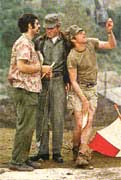 I don't think this movie has held up very well over time. Partly because the inventive way Robert Altman directed this film has been copied many times over the last few decades, but mainly because the movie spawned a television series that ended up being better then the original source. But when M*A*S*H came out in it's first release it was something quite new. The story follows a medical unit during the Korean War. It graphically showed bloody, war surgery for the first time (tame by present standards), and the crazy antics of the medics who used humor to deal with the horrors of war. This was Altman's first major success which he would follow with other 70's hits "McCabe and Mrs. Miller" (71), and "Nashville" (75). One technique Altman would use throughout his film career was the freedom he would give his actors. Many of the scenes would have realistic dialogue because the actors were allowed to improvise their lines. Appears on AFI's Best Movies of all time list at 58, but it shouldn't have made the list at all.
I don't think this movie has held up very well over time. Partly because the inventive way Robert Altman directed this film has been copied many times over the last few decades, but mainly because the movie spawned a television series that ended up being better then the original source. But when M*A*S*H came out in it's first release it was something quite new. The story follows a medical unit during the Korean War. It graphically showed bloody, war surgery for the first time (tame by present standards), and the crazy antics of the medics who used humor to deal with the horrors of war. This was Altman's first major success which he would follow with other 70's hits "McCabe and Mrs. Miller" (71), and "Nashville" (75). One technique Altman would use throughout his film career was the freedom he would give his actors. Many of the scenes would have realistic dialogue because the actors were allowed to improvise their lines. Appears on AFI's Best Movies of all time list at 58, but it shouldn't have made the list at all.
Network (1976)
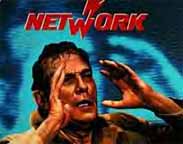 Like "A Clockwork Orange", this motion picture was a premonition of the future, but unlike "Orange" the ideas of this film have come to pass. The story is centered around a network, mainly the news department, and a decline in ratings. A change is made in management and a young Faye Dunaway is brought in to improve the network. The old anchor of the news, played by Peter Finch, is asked to leave. He can't take this and explains on air, that he's going to kill himself. This soon becomes a big ratings draw and Dunaway decides to continue with Finch as he begins to rant and rave with his own opinions, including the classic line, "I'm as mad as hell and I'm not gonna take this anymore." Wiliam Holden plays the older News Director who begins to have an affair with Dunaway even though he doesn't like her handling of the network and turning the news into an entertainment event. The ending may have been a little farfetched in the 70's, but seems like everyday fair in today's world of television hype, when an assasination is staged by the network to bring in more ratings. The film had more acting nominations than any other at the time, with an Oscar going to Finch, though he had died a few months before the ceremony. Appears on AFI's Best Movies of all time list at 66.
Like "A Clockwork Orange", this motion picture was a premonition of the future, but unlike "Orange" the ideas of this film have come to pass. The story is centered around a network, mainly the news department, and a decline in ratings. A change is made in management and a young Faye Dunaway is brought in to improve the network. The old anchor of the news, played by Peter Finch, is asked to leave. He can't take this and explains on air, that he's going to kill himself. This soon becomes a big ratings draw and Dunaway decides to continue with Finch as he begins to rant and rave with his own opinions, including the classic line, "I'm as mad as hell and I'm not gonna take this anymore." Wiliam Holden plays the older News Director who begins to have an affair with Dunaway even though he doesn't like her handling of the network and turning the news into an entertainment event. The ending may have been a little farfetched in the 70's, but seems like everyday fair in today's world of television hype, when an assasination is staged by the network to bring in more ratings. The film had more acting nominations than any other at the time, with an Oscar going to Finch, though he had died a few months before the ceremony. Appears on AFI's Best Movies of all time list at 66.
One Flew Over the Cuckoo's Nest (1975)

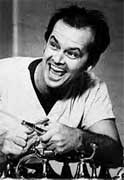 Believe it or not, I had never seen this film until I started making this list. After taking a quick glance through the films released in the 70's it was hard to pass up this movie. It was the first motion picture to win the top 5 Oscars (Picture, Actor, Actress, Director, & Screenplay) since "It Happened One Night" in 1934. It took quite some time for this story to make it to the screen. After starring in the play for a short time, Kirk Douglas had bought the rights for this story and asked an unknown, Milos Forman, to direct. Unfortunately, legal problems stopped production for 13 years and Kirk Douglas finally decided to forget about producing and passed the project on to his son, Michael Douglas. Michael got the ball rolling again, and unknown to him, asked the same Milos Forman, now quite successful, to direct. After putting together a wonderful cast of actors the film was finally in production. The story centers around Randall McMurphy, played by Jack Nicholson, who gets himself placed in a mental ward on purpose to get out of work duty in prison. While at the hospital, he begins to awaken a spirit in the other patients. Unfortunately, this new attitude is frowned upon by the authority, lead by the cold and insensitive head nurse Ratched. This rebellion finally ends with tragic circumstances. Told with heartfelt drama and humor the film is a triumph of the human spirit. Appears on AFI's Best Movies of all time list at 20.
Believe it or not, I had never seen this film until I started making this list. After taking a quick glance through the films released in the 70's it was hard to pass up this movie. It was the first motion picture to win the top 5 Oscars (Picture, Actor, Actress, Director, & Screenplay) since "It Happened One Night" in 1934. It took quite some time for this story to make it to the screen. After starring in the play for a short time, Kirk Douglas had bought the rights for this story and asked an unknown, Milos Forman, to direct. Unfortunately, legal problems stopped production for 13 years and Kirk Douglas finally decided to forget about producing and passed the project on to his son, Michael Douglas. Michael got the ball rolling again, and unknown to him, asked the same Milos Forman, now quite successful, to direct. After putting together a wonderful cast of actors the film was finally in production. The story centers around Randall McMurphy, played by Jack Nicholson, who gets himself placed in a mental ward on purpose to get out of work duty in prison. While at the hospital, he begins to awaken a spirit in the other patients. Unfortunately, this new attitude is frowned upon by the authority, lead by the cold and insensitive head nurse Ratched. This rebellion finally ends with tragic circumstances. Told with heartfelt drama and humor the film is a triumph of the human spirit. Appears on AFI's Best Movies of all time list at 20.
Rocky (1976)
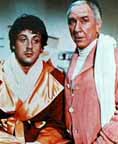
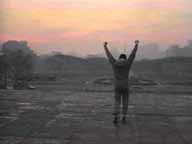 Every decade usually has one movie that people talk me into putting on the list. Here is the 70's film. I've never been a huge fan of Rocky and couldn't believe it won the Oscar for Best Picture. One of the problems is to judge the film by the 4 sequels that followed, each one growing progessively worse. The orginal film was a low-budget sleeper, written and starring an unknown named Sylvester Stallone. Stallone played A lowlife boxer from Philadelphia, named Rockey Balboa. Carl Weather's playing the world champion, who decides it would be a good marketing gimmick if he fights Balboa for the title. Burgess Meredith is the guff, old trainer Mickey whose task it is to get Rocky in shape. The sequence of Balboa running through the streets of Philly and jumping up the museum stairs, with the title theme bazzling in the background is very inspiring. Of course, Rocky falls in love along the way with the shy, timid woman. The film ends with the typic Hollywood uplifting battle between champion and underdog. Appears on AFI's Best Movies of all time list at 78.
Every decade usually has one movie that people talk me into putting on the list. Here is the 70's film. I've never been a huge fan of Rocky and couldn't believe it won the Oscar for Best Picture. One of the problems is to judge the film by the 4 sequels that followed, each one growing progessively worse. The orginal film was a low-budget sleeper, written and starring an unknown named Sylvester Stallone. Stallone played A lowlife boxer from Philadelphia, named Rockey Balboa. Carl Weather's playing the world champion, who decides it would be a good marketing gimmick if he fights Balboa for the title. Burgess Meredith is the guff, old trainer Mickey whose task it is to get Rocky in shape. The sequence of Balboa running through the streets of Philly and jumping up the museum stairs, with the title theme bazzling in the background is very inspiring. Of course, Rocky falls in love along the way with the shy, timid woman. The film ends with the typic Hollywood uplifting battle between champion and underdog. Appears on AFI's Best Movies of all time list at 78.
Saturday Night Fever (1977)
 It's hard to say that this movie is a great film. It isn't! But very few other motion pictures has effected the culture as much as this film did on it's initial release. When you review this list of films, it's amazing how much the music is a key element with almost all of them. It could be the memorable theme song, the classical music used, atmosphere music or classic songs from a particular era. This film created a new sound for a generation and it was called Disco. The soundtrack alone is still one of the best selling albums of all time. The story was inspired by a article in the New York Magazine titled, "Tribal Rites of the New Saturday Night" dealing with kids from Brooklyn who lived for saturdays at the local disco club. John Travolta, a teen star from television became a cult sensation as Tony Manerno whose only meaning in life was found on the dance floor. Besides for starting the disco craze, the fashion of polyester leisure suits and black shirts could be seen for a few years.
It's hard to say that this movie is a great film. It isn't! But very few other motion pictures has effected the culture as much as this film did on it's initial release. When you review this list of films, it's amazing how much the music is a key element with almost all of them. It could be the memorable theme song, the classical music used, atmosphere music or classic songs from a particular era. This film created a new sound for a generation and it was called Disco. The soundtrack alone is still one of the best selling albums of all time. The story was inspired by a article in the New York Magazine titled, "Tribal Rites of the New Saturday Night" dealing with kids from Brooklyn who lived for saturdays at the local disco club. John Travolta, a teen star from television became a cult sensation as Tony Manerno whose only meaning in life was found on the dance floor. Besides for starting the disco craze, the fashion of polyester leisure suits and black shirts could be seen for a few years.
Star Wars (1977)

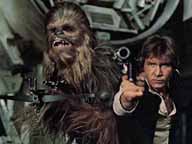 The movie that made George Lucas a legend. Taking elements from mythology, western serials, and the Nazi empire and combining them with amazing, art production and special effects to create a landmark film. The story is a simple tale of good vs. evil. A young, space farmer becomes involved in a war between a rebel force and the evil empire. His companions include a pair of robots, a princess, a mercenary and a hairy ape-like man, and a wise old sage. It's hard for me not to look at this film from a personal perspective. This movie had such a huge impact on how I viewed my childhood and how I view the cinema. This was the first "big person" movie I remember seeing. I was in second grade and my parents had taken my brother and I to the theater only to find it soldout. We purchased tickets for the next available show, which was about 4 hours later, an eternity for a 7 year old. When we finally sat down in the packed theater, the lights went low and then that short sentence appeared on the screen; "A long time ago, in a galaxy far, far away..." This huge musical chord of trumphets blast in my ears, and the giant, yellow words "Star Wars" appears from nowhere. My mom had to read the opening prologue as it moved across the screen. When the words were gone, the camera panned across the outer space sky (the first time a camera had panned through space) and this gigantic spaceship slowly began to cover the screen. I was hooked!!! For the next 8 years, I played, read, drew and slept Star Wars. In college, I discovered Joseph Campbell, a professor of world religions and myths, and the man Lucas had talked to when developing his story, and I fell in love with the film again. It appears on AFI's list of best films at ? and truely is one of the reasons movies are made! Appears on AFI's Best Movies of all time list at 15.
The movie that made George Lucas a legend. Taking elements from mythology, western serials, and the Nazi empire and combining them with amazing, art production and special effects to create a landmark film. The story is a simple tale of good vs. evil. A young, space farmer becomes involved in a war between a rebel force and the evil empire. His companions include a pair of robots, a princess, a mercenary and a hairy ape-like man, and a wise old sage. It's hard for me not to look at this film from a personal perspective. This movie had such a huge impact on how I viewed my childhood and how I view the cinema. This was the first "big person" movie I remember seeing. I was in second grade and my parents had taken my brother and I to the theater only to find it soldout. We purchased tickets for the next available show, which was about 4 hours later, an eternity for a 7 year old. When we finally sat down in the packed theater, the lights went low and then that short sentence appeared on the screen; "A long time ago, in a galaxy far, far away..." This huge musical chord of trumphets blast in my ears, and the giant, yellow words "Star Wars" appears from nowhere. My mom had to read the opening prologue as it moved across the screen. When the words were gone, the camera panned across the outer space sky (the first time a camera had panned through space) and this gigantic spaceship slowly began to cover the screen. I was hooked!!! For the next 8 years, I played, read, drew and slept Star Wars. In college, I discovered Joseph Campbell, a professor of world religions and myths, and the man Lucas had talked to when developing his story, and I fell in love with the film again. It appears on AFI's list of best films at ? and truely is one of the reasons movies are made! Appears on AFI's Best Movies of all time list at 15.
Taxi Driver (1976)
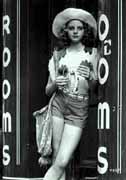
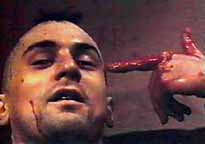 Three years after Scorsese's directoral debut with "Mean Street", he made this haunting tale of a psychotic cab driver working in New York City. Robert Deniro plays the title role of a Vietnam vet who has been alienated from most of society. He is a witness to the "enemies" of the city and tries to rescue a 12-year-old prostitute, played by a very young Jodie Foster. After being rejected by a beautiful woman (Cybil Shepherd), he snaps and prepares himself for battle, shaving his head and practicing his firearms before a mirror with the dialogue, "Are you talking to me?" The movie climaxes with an extremely violate rampage that was unseen to this point. Scorsese shot and pieced this film together like a master director and DeNiro continued to amaze with his acting talent. Not for everyone's taste, but riveting for those who will watch. Appears on AFI's Best Movies of all time list at 47.
Three years after Scorsese's directoral debut with "Mean Street", he made this haunting tale of a psychotic cab driver working in New York City. Robert Deniro plays the title role of a Vietnam vet who has been alienated from most of society. He is a witness to the "enemies" of the city and tries to rescue a 12-year-old prostitute, played by a very young Jodie Foster. After being rejected by a beautiful woman (Cybil Shepherd), he snaps and prepares himself for battle, shaving his head and practicing his firearms before a mirror with the dialogue, "Are you talking to me?" The movie climaxes with an extremely violate rampage that was unseen to this point. Scorsese shot and pieced this film together like a master director and DeNiro continued to amaze with his acting talent. Not for everyone's taste, but riveting for those who will watch. Appears on AFI's Best Movies of all time list at 47.
Young Frankenstein (1974)

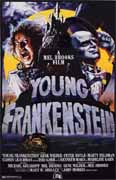 An absolutely wonderful comedy from Mel Brooks. During this same year Brooks also brought us "Blazing Saddles", a satire on the western, but where that film's humor was crude, this was intelligent. Brooks choose to satire the old Universal Horror films, specifically "Frankenstein" and "The Bride of Frankenstein". The casting was perfect. Gene Wilder plays Frankenstein, a professor who finds the research notebooks of his great grandfather, the Dr. Frankenstein of the original films. With the help of his finance, Teri Garr and Igor played by Marty Feldman, he decides to continue the experiments. The result is similiar to the orginal, with the monster, played by Peter Boyle, not quite what he is suppose to be. The film is even more special if you've seen both of the orginals, but not necessary. The scenes with Gene Hackman, as the Blind Man and Madeline Kahn, as the Monster's Bride are perfect. Brooks shot the film in Black and White, and used many of the same sets, especially the laboratory, found at the Universal lot. Possiblely the best satire ever.
An absolutely wonderful comedy from Mel Brooks. During this same year Brooks also brought us "Blazing Saddles", a satire on the western, but where that film's humor was crude, this was intelligent. Brooks choose to satire the old Universal Horror films, specifically "Frankenstein" and "The Bride of Frankenstein". The casting was perfect. Gene Wilder plays Frankenstein, a professor who finds the research notebooks of his great grandfather, the Dr. Frankenstein of the original films. With the help of his finance, Teri Garr and Igor played by Marty Feldman, he decides to continue the experiments. The result is similiar to the orginal, with the monster, played by Peter Boyle, not quite what he is suppose to be. The film is even more special if you've seen both of the orginals, but not necessary. The scenes with Gene Hackman, as the Blind Man and Madeline Kahn, as the Monster's Bride are perfect. Brooks shot the film in Black and White, and used many of the same sets, especially the laboratory, found at the Universal lot. Possiblely the best satire ever.
| |
|
|
Great Movie Moments from the Decade
To the MOVIES Homepage



 Before George Lucas became known as the man who created the Star Wars universe, he made another classic film, "American Graffiti". Francis Ford Coppola helped finance less than one million dollars, to this still somewhat unknown Lucas and his movie, which ended up being one of the top grossing films to this date. Based on Lucas's memories of his own teen years in Modesto, California, the film pays tribute to the innocent era of the early 60's. A time of driving around in cars with the top down, picking up girls, eating hamburgers at the drive-in, and listening to the radio. The soundtrack contains all the classics of the early rock era, and the cast would soon be all quite well known; Ron Howard, Richard Dreyfuss, Cindy Williams, Mackenzie Phillips, Suzanne Sommers, Wolfman Jack and Harrison Ford. Appears on AFI's Best Movies of all time list at 77.
Before George Lucas became known as the man who created the Star Wars universe, he made another classic film, "American Graffiti". Francis Ford Coppola helped finance less than one million dollars, to this still somewhat unknown Lucas and his movie, which ended up being one of the top grossing films to this date. Based on Lucas's memories of his own teen years in Modesto, California, the film pays tribute to the innocent era of the early 60's. A time of driving around in cars with the top down, picking up girls, eating hamburgers at the drive-in, and listening to the radio. The soundtrack contains all the classics of the early rock era, and the cast would soon be all quite well known; Ron Howard, Richard Dreyfuss, Cindy Williams, Mackenzie Phillips, Suzanne Sommers, Wolfman Jack and Harrison Ford. Appears on AFI's Best Movies of all time list at 77.
 This wonderful and humorous movie is based on the real life romance of the director and star, Woody Allen and the female lead Diane (nicknamed Annie) Keaton (real last name Hall). Woody Allen plays his basic neurotic, Jewish, New Yorker who is having relationship troubles, psychologically, religiously and culturally. The film follows his on-again, off-again relationship with Keaton, the all American midwest girl, told through flashbacks, monologues and short sequences. The film established Allen as a major director and Keaton started a fashion trend with her baggy pants, vest and hat. The movie is filled with classic lines and scenes, with my personal favorite being the couples first date, standing on a roof deck giving small talk, with subtitles below telling the audience what they are really thinking. Appears on AFI's Best Movies of all time list at 31.
This wonderful and humorous movie is based on the real life romance of the director and star, Woody Allen and the female lead Diane (nicknamed Annie) Keaton (real last name Hall). Woody Allen plays his basic neurotic, Jewish, New Yorker who is having relationship troubles, psychologically, religiously and culturally. The film follows his on-again, off-again relationship with Keaton, the all American midwest girl, told through flashbacks, monologues and short sequences. The film established Allen as a major director and Keaton started a fashion trend with her baggy pants, vest and hat. The movie is filled with classic lines and scenes, with my personal favorite being the couples first date, standing on a roof deck giving small talk, with subtitles below telling the audience what they are really thinking. Appears on AFI's Best Movies of all time list at 31.

 Francis Ford Coppola's nightmarish look at the Vietnam war. Inspired by Joseph Conrad's book, "Heart of Darkness", the story follows Captain Willard (played by Martin Sheen) and his danger-filled journey to find a man named Kurtz. This mysterious man, played by Marlon Brando, is a highly decorated U.S. officer that the army believes has gone mad. He has hid himself deep in the jungle and is posing as an idol to a native Cambodian tribe. The photography by Vittorio Storaro is mesmerizing and contains a kaleidoscope of war horrors. The ending is a little too surreal, murky and confusing, but I guess that sums up the war as well. I must admit, I was never a huge fan of this film, but I understand its artistic merit. Robert Duvall's scene showing him leading a armored assault on a beach, with Wagner's music blaring in the background, is a haunting image of the thirst for war by some people. Appears on AFI's Best Movies of all time list at 28 (Much too high).
Francis Ford Coppola's nightmarish look at the Vietnam war. Inspired by Joseph Conrad's book, "Heart of Darkness", the story follows Captain Willard (played by Martin Sheen) and his danger-filled journey to find a man named Kurtz. This mysterious man, played by Marlon Brando, is a highly decorated U.S. officer that the army believes has gone mad. He has hid himself deep in the jungle and is posing as an idol to a native Cambodian tribe. The photography by Vittorio Storaro is mesmerizing and contains a kaleidoscope of war horrors. The ending is a little too surreal, murky and confusing, but I guess that sums up the war as well. I must admit, I was never a huge fan of this film, but I understand its artistic merit. Robert Duvall's scene showing him leading a armored assault on a beach, with Wagner's music blaring in the background, is a haunting image of the thirst for war by some people. Appears on AFI's Best Movies of all time list at 28 (Much too high).
 One of the great things about making up these lists is the chance to revisit films I haven't seen in a long time and take another look. I put this movie on when I was writing this list and was happy to see Bob Fosse's classic musical again. It is very sad to think that this is possiblily the last great musical to come out of Hollywood. I'm not sure what happen to this genre, but it needs to be brought back!!! One of surprises about this film was the fact that it really took the musical into a new direction. The early musicals consisted of boy meets girl, boy loses girl, boy wins girl. A little conflict began to appear in "Oklahoma", "South Pacific", and "West Side Story", but they were still somewhat tame. "Cabaret" blew that all away. The story begins in Germany around 1931. The Nazis have not taken complete control of the country yet, and the local Cabaret is filled with fun, laughter and bawdy entertainment. An American singer, working at the club, begins to fall in love with a very proper Englishman. As the relationship grows, we begin to see the country slowly falling apart around them. Only in the 70's, could a film begin to portray bisexuality, easy women, and the horrors of Nazism with such taste. The movie was a star vehicle for Liza Minnelli, but I think the true star was Joel Grey as the "host" of the KitKat Club. Bob Fosse directed the film like no musical seen before, too bad others didn't pick up the trend.
One of the great things about making up these lists is the chance to revisit films I haven't seen in a long time and take another look. I put this movie on when I was writing this list and was happy to see Bob Fosse's classic musical again. It is very sad to think that this is possiblily the last great musical to come out of Hollywood. I'm not sure what happen to this genre, but it needs to be brought back!!! One of surprises about this film was the fact that it really took the musical into a new direction. The early musicals consisted of boy meets girl, boy loses girl, boy wins girl. A little conflict began to appear in "Oklahoma", "South Pacific", and "West Side Story", but they were still somewhat tame. "Cabaret" blew that all away. The story begins in Germany around 1931. The Nazis have not taken complete control of the country yet, and the local Cabaret is filled with fun, laughter and bawdy entertainment. An American singer, working at the club, begins to fall in love with a very proper Englishman. As the relationship grows, we begin to see the country slowly falling apart around them. Only in the 70's, could a film begin to portray bisexuality, easy women, and the horrors of Nazism with such taste. The movie was a star vehicle for Liza Minnelli, but I think the true star was Joel Grey as the "host" of the KitKat Club. Bob Fosse directed the film like no musical seen before, too bad others didn't pick up the trend. 
 This wonderful homage to the film noir of the 50's contains all the vintage elements. The film is set in Los Angeles during the 1930's. Jack Nicholson plays J.J. Gittes, a somewhat seedy private investigator who takes on a simple sounding case of infidelity. Faye Dunaway is the femme fatale who pulls Gittes into a complex mystery of false identities, investment schemes, controlling of the water supply and incest. Roman Polanski directs a moody picture from Robert Towne's wonderful script inspired by Chandler. Polanski also makes a cameo in the picture as a thug with a knife. The production design perfectly creates L.A. of the 30's and the tempo of the film accelerates as it pulls you deeper into the mystery. Appears on AFI's Best Movies of all time list at 19.
This wonderful homage to the film noir of the 50's contains all the vintage elements. The film is set in Los Angeles during the 1930's. Jack Nicholson plays J.J. Gittes, a somewhat seedy private investigator who takes on a simple sounding case of infidelity. Faye Dunaway is the femme fatale who pulls Gittes into a complex mystery of false identities, investment schemes, controlling of the water supply and incest. Roman Polanski directs a moody picture from Robert Towne's wonderful script inspired by Chandler. Polanski also makes a cameo in the picture as a thug with a knife. The production design perfectly creates L.A. of the 30's and the tempo of the film accelerates as it pulls you deeper into the mystery. Appears on AFI's Best Movies of all time list at 19.
 This movie has haunted me for quite some time. I'm not sure how old I was when I first saw it, but I know it was quite young, too young to understand what was going on. My brother had brought it home on video and I watched in horror. Is this what the future had in story for me? I had nightmares for days. This film still scares me, mainly because of how much of it seems to be coming true. The story is set in the not to distant future and centers around Alex (played by Malcolm McDowell) and his gang of "Droogs" whose purpose in life is to cause "a bit of the old ultraviolence". They search for innocent people that they can beat-up, torture, rape and kill. After a burtal assault, made even more terrifying with the joyful song "Signin in the Rain" being sung, Alex is captured by police and is sent to a reprogramming center. He is released after being brainwashed to decriminalize him. The question is, does this truly work? Taken from the Anthony Burgess novel, Stanley Kubrick continued with his amazing run of unique, creative and visually stunning motion pictures. This is NOT for everyone's taste and was orginally released with an X rating because of the violence. Most videos contain the R version, which is still shocking. Appears on AFI's Best Movies of all time list at 46.
This movie has haunted me for quite some time. I'm not sure how old I was when I first saw it, but I know it was quite young, too young to understand what was going on. My brother had brought it home on video and I watched in horror. Is this what the future had in story for me? I had nightmares for days. This film still scares me, mainly because of how much of it seems to be coming true. The story is set in the not to distant future and centers around Alex (played by Malcolm McDowell) and his gang of "Droogs" whose purpose in life is to cause "a bit of the old ultraviolence". They search for innocent people that they can beat-up, torture, rape and kill. After a burtal assault, made even more terrifying with the joyful song "Signin in the Rain" being sung, Alex is captured by police and is sent to a reprogramming center. He is released after being brainwashed to decriminalize him. The question is, does this truly work? Taken from the Anthony Burgess novel, Stanley Kubrick continued with his amazing run of unique, creative and visually stunning motion pictures. This is NOT for everyone's taste and was orginally released with an X rating because of the violence. Most videos contain the R version, which is still shocking. Appears on AFI's Best Movies of all time list at 46.
 Speilberg's second major release proved to the world that "Jaws" wasn't a one hit wonder for this young director, who also wrote the story for this film. And unlike most directors, Speilberg did not let the amazing special effects take away from the story. Richard Dreyfuss stars as one of many people who begin having strange dreams and sighting of UFO's. He begins to accept the truth that we are not alone, even though he is surrounded by a family of non-believers. This obsession eventual leads him to Devil's Tower mountian where the first contact with space beings occur. The story also threw a twist on many of the conceptions set up by sci-fi movies of the past fifty years. Gone were the Martians trying to take over the earth. In fact, most of the humans in the film are far more threatening than the childlike space aliens. Speilberg would continue this theme in the 80's with "ET". The last twenty mintues of the movie works like a silent film, with very little dialogue. The amazing visuals, sound (which won the film a special acheivement Oscar) and music by John Williams speak more than any words could say. I was luckily enough to catch this film on the big screen when it was first released. The arrival of the mothership was eye popping on the large scale. Appears on AFI's Best Movies of all time list at 64.
Speilberg's second major release proved to the world that "Jaws" wasn't a one hit wonder for this young director, who also wrote the story for this film. And unlike most directors, Speilberg did not let the amazing special effects take away from the story. Richard Dreyfuss stars as one of many people who begin having strange dreams and sighting of UFO's. He begins to accept the truth that we are not alone, even though he is surrounded by a family of non-believers. This obsession eventual leads him to Devil's Tower mountian where the first contact with space beings occur. The story also threw a twist on many of the conceptions set up by sci-fi movies of the past fifty years. Gone were the Martians trying to take over the earth. In fact, most of the humans in the film are far more threatening than the childlike space aliens. Speilberg would continue this theme in the 80's with "ET". The last twenty mintues of the movie works like a silent film, with very little dialogue. The amazing visuals, sound (which won the film a special acheivement Oscar) and music by John Williams speak more than any words could say. I was luckily enough to catch this film on the big screen when it was first released. The arrival of the mothership was eye popping on the large scale. Appears on AFI's Best Movies of all time list at 64. The first film to try and deal with the Vietnam War was groundbreaking. Blasted at first for being over 3 hours long and containing graphic voilence and racial stereotypes, the film ended up winning 5 Oscars including Best Picture. The story centers around 5 best friends from Pennsylvania who work together at the town steel plant in 1968. They hang out at the local bar drinking away their problems. One of the gang is getting married and it's the last time they will all be together since 3 of the guys are leaving in a few days for Vietnam. It cuts to them in a concentration camp as the men are made to play a terrifying game of Russian Roulette by their captors. The film shows events before during and after their war duty and depicts how this war effected everyone's lives. The cast was brillant, Robert DeNiro, Chistopher Walken, John Savage, John Cazale, Chuck Aspergen, and Meryl Streep. Wonderfully shows the friendships, heroics and horrors of man. Appears on AFI's Best Movies of all time list at 79.
The first film to try and deal with the Vietnam War was groundbreaking. Blasted at first for being over 3 hours long and containing graphic voilence and racial stereotypes, the film ended up winning 5 Oscars including Best Picture. The story centers around 5 best friends from Pennsylvania who work together at the town steel plant in 1968. They hang out at the local bar drinking away their problems. One of the gang is getting married and it's the last time they will all be together since 3 of the guys are leaving in a few days for Vietnam. It cuts to them in a concentration camp as the men are made to play a terrifying game of Russian Roulette by their captors. The film shows events before during and after their war duty and depicts how this war effected everyone's lives. The cast was brillant, Robert DeNiro, Chistopher Walken, John Savage, John Cazale, Chuck Aspergen, and Meryl Streep. Wonderfully shows the friendships, heroics and horrors of man. Appears on AFI's Best Movies of all time list at 79. One of the few Horror films to ever receive any form of critical recognition. Willim Peter Blatty adapted his own best selling book about a 12 year old girl who is possessed by the devil. Two men of the cloth, a young priest (Jason Miller) and an elderly father (Max von Sydow) are called upon to do battle and rid the girl of the evil spirit. Director William Friedkin used cold, dark shots highlighted by graphic visual effects, which would set the standard for the horror genre. The slow transformation of the young Linda Blair, as the possessed girl, into a hideous monster was made even more horrific because of certain graphic scenes the director or story placed her in, including the language used and sexual situation. It continues to freaks me out!
One of the few Horror films to ever receive any form of critical recognition. Willim Peter Blatty adapted his own best selling book about a 12 year old girl who is possessed by the devil. Two men of the cloth, a young priest (Jason Miller) and an elderly father (Max von Sydow) are called upon to do battle and rid the girl of the evil spirit. Director William Friedkin used cold, dark shots highlighted by graphic visual effects, which would set the standard for the horror genre. The slow transformation of the young Linda Blair, as the possessed girl, into a hideous monster was made even more horrific because of certain graphic scenes the director or story placed her in, including the language used and sexual situation. It continues to freaks me out! This film centers around Jimmy "Popeye" Doyle, a New York City cop intent on breaking up an international drug ring. Gene Hackman was wonderful as Doyle and Roy Scheider played his partner. The depiction of street life and dialogue had an almost documentary feel to it, with many of the scenes shot on location. The scene that stands out is the chase. In fact, when people talk about chase sequences in motion pictures this is one of the first films people think about. Considered the best and or most famous chase sequences in the history of cinema People have tried to copy it, but never reach it's intensity and suspense. Popeye is on the tail of a suspect who hops aboard an elevated train. Hackman follows underneath in a car with very little regard to anyone or anything in his way. The chase ends with one of the classic images from the movies. It's been awhile since I've seen this film and I remember being a little disappointed in the ending, but the chase alone is worth a viewing. Appears on AFI's Best Movies of all time list at 70.
This film centers around Jimmy "Popeye" Doyle, a New York City cop intent on breaking up an international drug ring. Gene Hackman was wonderful as Doyle and Roy Scheider played his partner. The depiction of street life and dialogue had an almost documentary feel to it, with many of the scenes shot on location. The scene that stands out is the chase. In fact, when people talk about chase sequences in motion pictures this is one of the first films people think about. Considered the best and or most famous chase sequences in the history of cinema People have tried to copy it, but never reach it's intensity and suspense. Popeye is on the tail of a suspect who hops aboard an elevated train. Hackman follows underneath in a car with very little regard to anyone or anything in his way. The chase ends with one of the classic images from the movies. It's been awhile since I've seen this film and I remember being a little disappointed in the ending, but the chase alone is worth a viewing. Appears on AFI's Best Movies of all time list at 70.
 O.K. I admit, I cheated a little here. I realize that these are two seperate films, but even Coppola reedited these two movies together in chronological order and released it as "The Godfather Epic" in 1977. The story is taken from Mario Puzo's popular novel that follows the lives of the Corleones, an Italian family involved with the criminal Mafia. The first film tells of the final years of "the godfather", played by Marlon Brando, and his family who must begin to take over his father's criminal business. Al Pacino stars as the somewhat shy and timid, young son, who really wants nothing to do with the business, but eventual gets sucked into becoming the leader. The second film continues to follow Pacino as he turns the family crime business into a cold, sleek and mordern day organization. The second also goes back into time to show the orginal godfather, Brando's character now played by Robert DeNiro, as an ambitous, young immigrant in NYC and how he fell into the crime underworld. One element both films have is outstanding acting. You just can't find a better cast; besides for Brando, Pacino and DeNiro, they included James Caan, Robert Duvall, and Diane Keaton. Coppola also used amazing technical and storytelling skills to weave an epic tale over a two generational period of time. Considered an artistic masterpeice, but may be a little high on AFI's list of all-time movies at 3 & 32.
O.K. I admit, I cheated a little here. I realize that these are two seperate films, but even Coppola reedited these two movies together in chronological order and released it as "The Godfather Epic" in 1977. The story is taken from Mario Puzo's popular novel that follows the lives of the Corleones, an Italian family involved with the criminal Mafia. The first film tells of the final years of "the godfather", played by Marlon Brando, and his family who must begin to take over his father's criminal business. Al Pacino stars as the somewhat shy and timid, young son, who really wants nothing to do with the business, but eventual gets sucked into becoming the leader. The second film continues to follow Pacino as he turns the family crime business into a cold, sleek and mordern day organization. The second also goes back into time to show the orginal godfather, Brando's character now played by Robert DeNiro, as an ambitous, young immigrant in NYC and how he fell into the crime underworld. One element both films have is outstanding acting. You just can't find a better cast; besides for Brando, Pacino and DeNiro, they included James Caan, Robert Duvall, and Diane Keaton. Coppola also used amazing technical and storytelling skills to weave an epic tale over a two generational period of time. Considered an artistic masterpeice, but may be a little high on AFI's list of all-time movies at 3 & 32. 
 The movie that put Steven Speilberg on the map. Adapted from the Peter Benchley novel and directed by Speilberg who was only 27 at the time. The story follows a giant, great white shark that is terrorizing a local resort beach during the height of the 4th of July tourist season. The town's sheriff, a shark expert and a local big sea fisherman, played wonderfully by Roy Scheider, Richard Dreyfuss and Robert Shaw, set out to try and kill the "monster". Speilberg had major technical difficulities with the mechanical shark (named Bruce) when filming began, which meant the shark wasn't seen until the last quarter of the film. If anything, this only heighten the suspense. John Williams won a well deserved Oscar for the now classic musical score. The film was the first summer mega-hit and started the summer blackbuster trend. Appears on AFI's Best Movies of all time list at 48.
The movie that put Steven Speilberg on the map. Adapted from the Peter Benchley novel and directed by Speilberg who was only 27 at the time. The story follows a giant, great white shark that is terrorizing a local resort beach during the height of the 4th of July tourist season. The town's sheriff, a shark expert and a local big sea fisherman, played wonderfully by Roy Scheider, Richard Dreyfuss and Robert Shaw, set out to try and kill the "monster". Speilberg had major technical difficulities with the mechanical shark (named Bruce) when filming began, which meant the shark wasn't seen until the last quarter of the film. If anything, this only heighten the suspense. John Williams won a well deserved Oscar for the now classic musical score. The film was the first summer mega-hit and started the summer blackbuster trend. Appears on AFI's Best Movies of all time list at 48.  I don't think this movie has held up very well over time. Partly because the inventive way Robert Altman directed this film has been copied many times over the last few decades, but mainly because the movie spawned a television series that ended up being better then the original source. But when M*A*S*H came out in it's first release it was something quite new. The story follows a medical unit during the Korean War. It graphically showed bloody, war surgery for the first time (tame by present standards), and the crazy antics of the medics who used humor to deal with the horrors of war. This was Altman's first major success which he would follow with other 70's hits "McCabe and Mrs. Miller" (71), and "Nashville" (75). One technique Altman would use throughout his film career was the freedom he would give his actors. Many of the scenes would have realistic dialogue because the actors were allowed to improvise their lines. Appears on AFI's Best Movies of all time list at 58, but it shouldn't have made the list at all.
I don't think this movie has held up very well over time. Partly because the inventive way Robert Altman directed this film has been copied many times over the last few decades, but mainly because the movie spawned a television series that ended up being better then the original source. But when M*A*S*H came out in it's first release it was something quite new. The story follows a medical unit during the Korean War. It graphically showed bloody, war surgery for the first time (tame by present standards), and the crazy antics of the medics who used humor to deal with the horrors of war. This was Altman's first major success which he would follow with other 70's hits "McCabe and Mrs. Miller" (71), and "Nashville" (75). One technique Altman would use throughout his film career was the freedom he would give his actors. Many of the scenes would have realistic dialogue because the actors were allowed to improvise their lines. Appears on AFI's Best Movies of all time list at 58, but it shouldn't have made the list at all. Like "A Clockwork Orange", this motion picture was a premonition of the future, but unlike "Orange" the ideas of this film have come to pass. The story is centered around a network, mainly the news department, and a decline in ratings. A change is made in management and a young Faye Dunaway is brought in to improve the network. The old anchor of the news, played by Peter Finch, is asked to leave. He can't take this and explains on air, that he's going to kill himself. This soon becomes a big ratings draw and Dunaway decides to continue with Finch as he begins to rant and rave with his own opinions, including the classic line, "I'm as mad as hell and I'm not gonna take this anymore." Wiliam Holden plays the older News Director who begins to have an affair with Dunaway even though he doesn't like her handling of the network and turning the news into an entertainment event. The ending may have been a little farfetched in the 70's, but seems like everyday fair in today's world of television hype, when an assasination is staged by the network to bring in more ratings. The film had more acting nominations than any other at the time, with an Oscar going to Finch, though he had died a few months before the ceremony. Appears on AFI's Best Movies of all time list at 66.
Like "A Clockwork Orange", this motion picture was a premonition of the future, but unlike "Orange" the ideas of this film have come to pass. The story is centered around a network, mainly the news department, and a decline in ratings. A change is made in management and a young Faye Dunaway is brought in to improve the network. The old anchor of the news, played by Peter Finch, is asked to leave. He can't take this and explains on air, that he's going to kill himself. This soon becomes a big ratings draw and Dunaway decides to continue with Finch as he begins to rant and rave with his own opinions, including the classic line, "I'm as mad as hell and I'm not gonna take this anymore." Wiliam Holden plays the older News Director who begins to have an affair with Dunaway even though he doesn't like her handling of the network and turning the news into an entertainment event. The ending may have been a little farfetched in the 70's, but seems like everyday fair in today's world of television hype, when an assasination is staged by the network to bring in more ratings. The film had more acting nominations than any other at the time, with an Oscar going to Finch, though he had died a few months before the ceremony. Appears on AFI's Best Movies of all time list at 66.
 Believe it or not, I had never seen this film until I started making this list. After taking a quick glance through the films released in the 70's it was hard to pass up this movie. It was the first motion picture to win the top 5 Oscars (Picture, Actor, Actress, Director, & Screenplay) since "It Happened One Night" in 1934. It took quite some time for this story to make it to the screen. After starring in the play for a short time, Kirk Douglas had bought the rights for this story and asked an unknown, Milos Forman, to direct. Unfortunately, legal problems stopped production for 13 years and Kirk Douglas finally decided to forget about producing and passed the project on to his son, Michael Douglas. Michael got the ball rolling again, and unknown to him, asked the same Milos Forman, now quite successful, to direct. After putting together a wonderful cast of actors the film was finally in production. The story centers around Randall McMurphy, played by Jack Nicholson, who gets himself placed in a mental ward on purpose to get out of work duty in prison. While at the hospital, he begins to awaken a spirit in the other patients. Unfortunately, this new attitude is frowned upon by the authority, lead by the cold and insensitive head nurse Ratched. This rebellion finally ends with tragic circumstances. Told with heartfelt drama and humor the film is a triumph of the human spirit. Appears on AFI's Best Movies of all time list at 20.
Believe it or not, I had never seen this film until I started making this list. After taking a quick glance through the films released in the 70's it was hard to pass up this movie. It was the first motion picture to win the top 5 Oscars (Picture, Actor, Actress, Director, & Screenplay) since "It Happened One Night" in 1934. It took quite some time for this story to make it to the screen. After starring in the play for a short time, Kirk Douglas had bought the rights for this story and asked an unknown, Milos Forman, to direct. Unfortunately, legal problems stopped production for 13 years and Kirk Douglas finally decided to forget about producing and passed the project on to his son, Michael Douglas. Michael got the ball rolling again, and unknown to him, asked the same Milos Forman, now quite successful, to direct. After putting together a wonderful cast of actors the film was finally in production. The story centers around Randall McMurphy, played by Jack Nicholson, who gets himself placed in a mental ward on purpose to get out of work duty in prison. While at the hospital, he begins to awaken a spirit in the other patients. Unfortunately, this new attitude is frowned upon by the authority, lead by the cold and insensitive head nurse Ratched. This rebellion finally ends with tragic circumstances. Told with heartfelt drama and humor the film is a triumph of the human spirit. Appears on AFI's Best Movies of all time list at 20.
 Every decade usually has one movie that people talk me into putting on the list. Here is the 70's film. I've never been a huge fan of Rocky and couldn't believe it won the Oscar for Best Picture. One of the problems is to judge the film by the 4 sequels that followed, each one growing progessively worse. The orginal film was a low-budget sleeper, written and starring an unknown named Sylvester Stallone. Stallone played A lowlife boxer from Philadelphia, named Rockey Balboa. Carl Weather's playing the world champion, who decides it would be a good marketing gimmick if he fights Balboa for the title. Burgess Meredith is the guff, old trainer Mickey whose task it is to get Rocky in shape. The sequence of Balboa running through the streets of Philly and jumping up the museum stairs, with the title theme bazzling in the background is very inspiring. Of course, Rocky falls in love along the way with the shy, timid woman. The film ends with the typic Hollywood uplifting battle between champion and underdog. Appears on AFI's Best Movies of all time list at 78.
Every decade usually has one movie that people talk me into putting on the list. Here is the 70's film. I've never been a huge fan of Rocky and couldn't believe it won the Oscar for Best Picture. One of the problems is to judge the film by the 4 sequels that followed, each one growing progessively worse. The orginal film was a low-budget sleeper, written and starring an unknown named Sylvester Stallone. Stallone played A lowlife boxer from Philadelphia, named Rockey Balboa. Carl Weather's playing the world champion, who decides it would be a good marketing gimmick if he fights Balboa for the title. Burgess Meredith is the guff, old trainer Mickey whose task it is to get Rocky in shape. The sequence of Balboa running through the streets of Philly and jumping up the museum stairs, with the title theme bazzling in the background is very inspiring. Of course, Rocky falls in love along the way with the shy, timid woman. The film ends with the typic Hollywood uplifting battle between champion and underdog. Appears on AFI's Best Movies of all time list at 78. It's hard to say that this movie is a great film. It isn't! But very few other motion pictures has effected the culture as much as this film did on it's initial release. When you review this list of films, it's amazing how much the music is a key element with almost all of them. It could be the memorable theme song, the classical music used, atmosphere music or classic songs from a particular era. This film created a new sound for a generation and it was called Disco. The soundtrack alone is still one of the best selling albums of all time. The story was inspired by a article in the New York Magazine titled, "Tribal Rites of the New Saturday Night" dealing with kids from Brooklyn who lived for saturdays at the local disco club. John Travolta, a teen star from television became a cult sensation as Tony Manerno whose only meaning in life was found on the dance floor. Besides for starting the disco craze, the fashion of polyester leisure suits and black shirts could be seen for a few years.
It's hard to say that this movie is a great film. It isn't! But very few other motion pictures has effected the culture as much as this film did on it's initial release. When you review this list of films, it's amazing how much the music is a key element with almost all of them. It could be the memorable theme song, the classical music used, atmosphere music or classic songs from a particular era. This film created a new sound for a generation and it was called Disco. The soundtrack alone is still one of the best selling albums of all time. The story was inspired by a article in the New York Magazine titled, "Tribal Rites of the New Saturday Night" dealing with kids from Brooklyn who lived for saturdays at the local disco club. John Travolta, a teen star from television became a cult sensation as Tony Manerno whose only meaning in life was found on the dance floor. Besides for starting the disco craze, the fashion of polyester leisure suits and black shirts could be seen for a few years.
 The movie that made George Lucas a legend. Taking elements from mythology, western serials, and the Nazi empire and combining them with amazing, art production and special effects to create a landmark film. The story is a simple tale of good vs. evil. A young, space farmer becomes involved in a war between a rebel force and the evil empire. His companions include a pair of robots, a princess, a mercenary and a hairy ape-like man, and a wise old sage. It's hard for me not to look at this film from a personal perspective. This movie had such a huge impact on how I viewed my childhood and how I view the cinema. This was the first "big person" movie I remember seeing. I was in second grade and my parents had taken my brother and I to the theater only to find it soldout. We purchased tickets for the next available show, which was about 4 hours later, an eternity for a 7 year old. When we finally sat down in the packed theater, the lights went low and then that short sentence appeared on the screen; "A long time ago, in a galaxy far, far away..." This huge musical chord of trumphets blast in my ears, and the giant, yellow words "Star Wars" appears from nowhere. My mom had to read the opening prologue as it moved across the screen. When the words were gone, the camera panned across the outer space sky (the first time a camera had panned through space) and this gigantic spaceship slowly began to cover the screen. I was hooked!!! For the next 8 years, I played, read, drew and slept Star Wars. In college, I discovered Joseph Campbell, a professor of world religions and myths, and the man Lucas had talked to when developing his story, and I fell in love with the film again. It appears on AFI's list of best films at ? and truely is one of the reasons movies are made! Appears on AFI's Best Movies of all time list at 15.
The movie that made George Lucas a legend. Taking elements from mythology, western serials, and the Nazi empire and combining them with amazing, art production and special effects to create a landmark film. The story is a simple tale of good vs. evil. A young, space farmer becomes involved in a war between a rebel force and the evil empire. His companions include a pair of robots, a princess, a mercenary and a hairy ape-like man, and a wise old sage. It's hard for me not to look at this film from a personal perspective. This movie had such a huge impact on how I viewed my childhood and how I view the cinema. This was the first "big person" movie I remember seeing. I was in second grade and my parents had taken my brother and I to the theater only to find it soldout. We purchased tickets for the next available show, which was about 4 hours later, an eternity for a 7 year old. When we finally sat down in the packed theater, the lights went low and then that short sentence appeared on the screen; "A long time ago, in a galaxy far, far away..." This huge musical chord of trumphets blast in my ears, and the giant, yellow words "Star Wars" appears from nowhere. My mom had to read the opening prologue as it moved across the screen. When the words were gone, the camera panned across the outer space sky (the first time a camera had panned through space) and this gigantic spaceship slowly began to cover the screen. I was hooked!!! For the next 8 years, I played, read, drew and slept Star Wars. In college, I discovered Joseph Campbell, a professor of world religions and myths, and the man Lucas had talked to when developing his story, and I fell in love with the film again. It appears on AFI's list of best films at ? and truely is one of the reasons movies are made! Appears on AFI's Best Movies of all time list at 15.
 Three years after Scorsese's directoral debut with "Mean Street", he made this haunting tale of a psychotic cab driver working in New York City. Robert Deniro plays the title role of a Vietnam vet who has been alienated from most of society. He is a witness to the "enemies" of the city and tries to rescue a 12-year-old prostitute, played by a very young Jodie Foster. After being rejected by a beautiful woman (Cybil Shepherd), he snaps and prepares himself for battle, shaving his head and practicing his firearms before a mirror with the dialogue, "Are you talking to me?" The movie climaxes with an extremely violate rampage that was unseen to this point. Scorsese shot and pieced this film together like a master director and DeNiro continued to amaze with his acting talent. Not for everyone's taste, but riveting for those who will watch. Appears on AFI's Best Movies of all time list at 47.
Three years after Scorsese's directoral debut with "Mean Street", he made this haunting tale of a psychotic cab driver working in New York City. Robert Deniro plays the title role of a Vietnam vet who has been alienated from most of society. He is a witness to the "enemies" of the city and tries to rescue a 12-year-old prostitute, played by a very young Jodie Foster. After being rejected by a beautiful woman (Cybil Shepherd), he snaps and prepares himself for battle, shaving his head and practicing his firearms before a mirror with the dialogue, "Are you talking to me?" The movie climaxes with an extremely violate rampage that was unseen to this point. Scorsese shot and pieced this film together like a master director and DeNiro continued to amaze with his acting talent. Not for everyone's taste, but riveting for those who will watch. Appears on AFI's Best Movies of all time list at 47.

 An absolutely wonderful comedy from Mel Brooks. During this same year Brooks also brought us "Blazing Saddles", a satire on the western, but where that film's humor was crude, this was intelligent. Brooks choose to satire the old Universal Horror films, specifically "Frankenstein" and "The Bride of Frankenstein". The casting was perfect. Gene Wilder plays Frankenstein, a professor who finds the research notebooks of his great grandfather, the Dr. Frankenstein of the original films. With the help of his finance, Teri Garr and Igor played by Marty Feldman, he decides to continue the experiments. The result is similiar to the orginal, with the monster, played by Peter Boyle, not quite what he is suppose to be. The film is even more special if you've seen both of the orginals, but not necessary. The scenes with Gene Hackman, as the Blind Man and Madeline Kahn, as the Monster's Bride are perfect. Brooks shot the film in Black and White, and used many of the same sets, especially the laboratory, found at the Universal lot. Possiblely the best satire ever.
An absolutely wonderful comedy from Mel Brooks. During this same year Brooks also brought us "Blazing Saddles", a satire on the western, but where that film's humor was crude, this was intelligent. Brooks choose to satire the old Universal Horror films, specifically "Frankenstein" and "The Bride of Frankenstein". The casting was perfect. Gene Wilder plays Frankenstein, a professor who finds the research notebooks of his great grandfather, the Dr. Frankenstein of the original films. With the help of his finance, Teri Garr and Igor played by Marty Feldman, he decides to continue the experiments. The result is similiar to the orginal, with the monster, played by Peter Boyle, not quite what he is suppose to be. The film is even more special if you've seen both of the orginals, but not necessary. The scenes with Gene Hackman, as the Blind Man and Madeline Kahn, as the Monster's Bride are perfect. Brooks shot the film in Black and White, and used many of the same sets, especially the laboratory, found at the Universal lot. Possiblely the best satire ever.